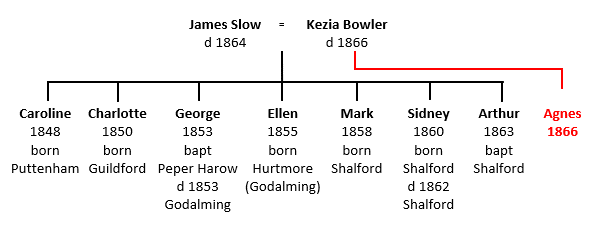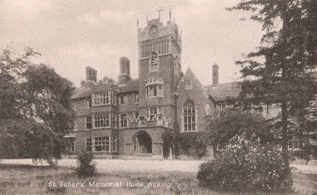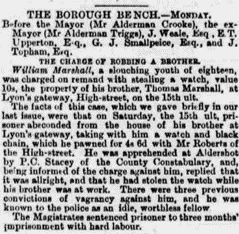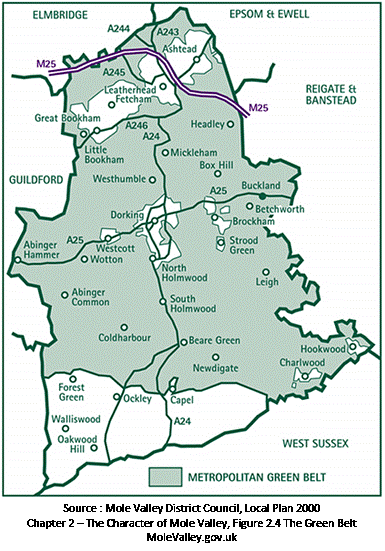Agnes Slow
Subject Name : Agnes Slow (b ca 1866 – d 1943)
Researchers : Christine Clarke and Mike Brock
Agnes Slow was a remarkable woman. Orphaned as a baby, she was raised, educated and trained in the Guildford Union Workhouse. She suffered a debilitating illness as a young adult before going through a traumatic time while working in a hospital but went on to successfully raise a family with a reformed character who had previously spent some 15 years in prison.
Agnes was the illegitimate daughter of Keziah Slow, probably born in Guildford on 24th January 1866. The reason for this lack of clarity is that neither an official birth certificate nor baptism record has been traced for her. There are many possible reasons for this, but what is certain is that Agnes’ mother Keziah was in a very difficult situation.
Keziah Bowler had married Godalming-born agricultural labourer James Slow on 26th September 1847 in Puttenham, Surrey . Their family quickly grew and moved around different Surrey villages as James sought work on the land.
. Their family quickly grew and moved around different Surrey villages as James sought work on the land.
Unfortunately, James died at the age of 42 and was buried on 30th June 1864 at the church of St Mary the Virgin, Shalford.
With the death of James, the main breadwinner, it seems certain that Keziah and their five surviving children, the youngest being just over a year old, would have been plunged into poverty. This is confirmed by the Guildford Poor Law Relief half-yearly accounts book which shows that Kezia received aid which would have kept the family out of the Workhouse.
During this bleak time for the family, Keziah gave birth to Agnes, but more tragedy followed three months later when Keziah passed away age 39 from ‘typhus fever’ on 23rd April 1866 in Quarry Hill, Guildford. The death certificate named her as ‘Kesiah Stoe’, saying that she was the widow of agricultural labourer ‘William Stoe’. The witness to the death was not one of Keziah’s children which probably explains the misspelt surname. It may, however, indicate that Agnes’ father could have been called William although there is no record to show that a marriage had taken place or confirm who he might have been.
Now orphaned and without visible means of support, Agnes, along with her youngest half-siblings Ellen, Mark and Arthur, were thrown into the Poor Relief system and sent to the Guildford Union Workhouse.
One benefit that workhouse children had compared to others outside the system at this time was that they received a basic education before it became compulsory in England in 1880. The Guildford Union Workhouse School had been built in 1856. Training for employment was also given so that workhouse children might prove to be self-sufficient when they left, usually around the age of 13.
This is almost certainly what happened with Ellen, the oldest of the quartet, as the 1871 Census showed her to be working as a servant in Paddington, London. Agnes, age 5, and her half-brothers Mark, 11, (actually 13), and Arthur, 8, were listed as scholars in the Guildford Union Workhouse.
Mark also seemed to benefit from the Guildford Union system because he became a shoemaker and was able to go on to support a wife and her family in London. Arthur followed in his late father’s footsteps to work on the land, and by 1881, was employed and living on a farm at Highcombe Bottom, Elstead, near Godalming.
Thus, in the 1881 Census, Agnes, 14 (actually 15) and still described as a scholar, was the only one of the Slow family remaining in the Workhouse. Like her half-sister Ellen, Agnes almost certainly would have been receiving training to be in service.
This is what seemed to have happened, since the next traced official record for Agnes described her as a 23-year-old ‘general servant’ from Guildford, as a patient at St. Peter’s Memorial Home, Maybury Hill, Woking. She had been admitted on 28th July 1890, and was now calling herself Agnes Kezia Slow, having adopted her mother’s name.
S t Peter’s Memorial Home opened in October 1885 to provide for ‘incurables’ and to admit patients that were refused by other homes. It was run by the Anglican Sisterhood of St Peter, which had been established by benefactors in 1861 as a religious community devoted to nursing, seeking to help the impoverished sick, and provide convalescent care for women and children.
t Peter’s Memorial Home opened in October 1885 to provide for ‘incurables’ and to admit patients that were refused by other homes. It was run by the Anglican Sisterhood of St Peter, which had been established by benefactors in 1861 as a religious community devoted to nursing, seeking to help the impoverished sick, and provide convalescent care for women and children.
Agnes’s details in the hospital register were written by one Sister Ella. Agnes was in a ‘Guildford flu bed’ and had been recommended by Miss Ada Greenaway of Staffa Lodge, Waterden Road, Guildford. Interestingly, her guarantor was Miss Dodgson of The Chestnuts, Guildford, sister of author Charles Dodgson, better known by his pseudonym, Lewis Carroll.
Sister Ella described Agnes as having been ill for about a year, suffering from debility and bronchitis. Her biographical details stated that both her parents were dead, that her father’s name was unknown and that she had been sent to the Guildford Union Workhouse at around three months old. Agnes had been educated in the Workhouse school and sent into service at the age of 13. She had been confirmed a year later at Christ Church, Waterden Road, Guildford.
On 10th October 1890, Agnes was transferred to The Brompton Hospital, London. Then, as now, this establishment specialised in the treatment of chest infections and complaints. Agnes was admitted onto Princess Ward with her place of residence given as ‘c/o Miss Dodgson, The Chestnuts, Guildford’. Happily, she was discharged 12 days later, the hospital stating that her condition was ‘improved’ and that she had no chest disease.
Whether Agnes returned to Guildford is not clear, but the following year on 5th April 1891, the date of the Census, Agnes was boarding at 43 Southwater Road, Hastings (now St Leonards-on-Sea), Sussex. She was an unmarried 24-year-old domestic servant, with the head of this establishment Louisa Baker described as a ‘Matron’. Apart from Louisa’s seven-year-old nephew and two servants, there were seven young unmarried women including Agnes boarding there, mainly servants. Perhaps Agnes was there for recuperation in the fresh sea air, or she might potentially have been undertaking some basic nursing training as a servant at one of the many nearby hospitals. The Buchanan Cottage Hospital had originally been at 24 Southwater Road from 1881 to 1884, before being relocated to larger premises nearby. As Agnes had recently spent nearly three months being treated in hospital, she may have gained an interest in nursing through that.
Agnes did not stay long in Hastings, soon returning to Guildford to begin working at the Guildford Isolation Hospital. She was employed as a casual nurse, meaning that she was not fully trained. Patients at the hospital were suffering from conditions such as diphtheria and it was the death of three-year-old Ethel Heilbron in December 1892 while 26-year-old Agnes was on duty with no qualified nurse available that led to a public inquiry into the circumstances. At the hearing, the Medical Officer of the hospital Thomas Schollick said that shortly before the child had died, he had requested for a trained nurse to work in the diphtheria ward, but no one was available. Mr Schollick said that Agnes ‘had done her best’ but she was not a fully trained nurse and could not be held responsible for Ethel’s death. No blame therefore was attached to Agnes, but further investigation within the hospital was carried out to attempt to resolve its working practices which had left Agnes in such an awful position.
This was clearly a distressing episode for her, and it is not known whether Agnes was able to continue to work at the hospital.
The fortunes of Agnes had changed for the better by the time of the 1901 Census which showed her apparently married to William D Marshall, 41, a gravel digger born in Normandy, Surrey. They were boarding at 12 Queen’s Road, Stoke, Guildford. No marriage record has been traced. It is possible that they had known each other for a long time as 20 years previously Agnes was in the Workhouse with two of William’s younger siblings and his widowed father. With no admission records available, it is not known if William, six years older than Agnes, had also been there sometime during her childhood.
William, going by what was stated in that 1881 Census, had appeared to have been doing well 29.  He was described as a 22-year-old unmarried private soldier in the 66th Regiment of Foot, visiting his brother George in North Square, Stoke Next Guildford. The full truth, however, was somewhat different, as five months later, William was sentenced to three months imprisonment for ‘false enlistment’. This had followed a catalogue of convictions since 1876 which included William stealing a watch from his brother Thomas. Worse was to follow, as on 4th June 1883, William was sentenced to seven years in gaol for a ‘brutal and unprovoked assault’ on a woman.
He was described as a 22-year-old unmarried private soldier in the 66th Regiment of Foot, visiting his brother George in North Square, Stoke Next Guildford. The full truth, however, was somewhat different, as five months later, William was sentenced to three months imprisonment for ‘false enlistment’. This had followed a catalogue of convictions since 1876 which included William stealing a watch from his brother Thomas. Worse was to follow, as on 4th June 1883, William was sentenced to seven years in gaol for a ‘brutal and unprovoked assault’ on a woman.
Eleven years later, acting under the pseudonym William Jones, he received another seven-year sentence, again for robbery and assault of a woman. 34-year-old William was sent to  Borstal Prison, Rochester, Kent which at that time housed both adult and juvenile offenders.
Borstal Prison, Rochester, Kent which at that time housed both adult and juvenile offenders.
William was released on 13th January 1900. His intended address was 29 Brooke Street, Holborn, the location of St Giles Christian Mission which carried out relief work with discharged offenders. This was just a few weeks short of his 40th birthday.
What brought Agnes and William together in Guildford in the following year is likely to remain unknown, but it was undoubtedly a huge turning point in both of their lives.
Agnes and William’s first child Rosie May was born on 15th August 1903 in Abinger Hammer, a small village in the Mole valley just west of Dorking. Sadly she died just a few months later.  A second child, William Richard, was born there on 14th December 1904, with a daughter Agnes following on 25th July 1906.
A second child, William Richard, was born there on 14th December 1904, with a daughter Agnes following on 25th July 1906.
By the time of the 1911 Census, the family had moved a short distance east to Westcott, living at 2 Rose Cottage, St John’s Road. Mother Agnes was 41 (actually 45), husband William a 51-year-old farm labourer and children William, 6, and Agnes, 4. They also had a lodger.
The family were still in St John’s Road in the 1921 Census, with Agnes and William having adopted Arthur Albert Marshall who was born in 1919 in Dorking. William, 61, and 16-year-old son William were both employed as builder’s labourers in Abinger. Like in 1911, the family was still accommodating a lodger.
Daughter Agnes married Percy Plaw in 1928, remaining in St John’s Road. Three children were born there – Frank in 1930, Dorothy (also known as Joyce) a year later and Margaret in 1935. Electoral rolls for 1936 showed that the new grandparents Agnes and William were at 4 Sandy Lane, Westcott, while the young family had moved to 4 Parsonage Lane, Westcott. Agnes and William’s son William had married Charlotte Fuller in 1934 and they settled just a few miles away in Brockham.
By the time of the 1939 Register 73-year-old Agnes – mistakenly noted as 83 – and husband William, 79, a retired general labourer, had moved in with their daughter Agnes and family at 4 Parsonage Lane. Agnes and William’s adopted son Arthur, 19, an electric cooker assembler, completed the household.
World War II had begun on 3rd September a few weeks before the Register was taken, so it was not long before Arthur enlisted in the Army, joining the Queen’s Royal West Surrey Regiment on 15th November. He was to survive the conflict, living into his nineties.
Just over five weeks after Arthur signed on, William passed away at home on 20th December age 79. Agnes remained with her daughter and family until she died from “myocardial degeneration”, age 77 at home on 16th June 1943.
April 2023, updated November 2023
Sources
Ancestry.co.uk
Barts Health NHS Trust Archives
FamilySearch.org
FindMyPast.co.uk / British Newspaper Archive
General Register Office GRO.gov.uk
HistoryMap.info/Buchanan Hospital
Surrey History Centre, Woking Surreycc.gov.uk
The Institutional History Society InstitutionalHistory.com
The Spike Heritage Centre GuildfordSpike.co.uk
Wikipedia.co.uk
For a full list of references click here
